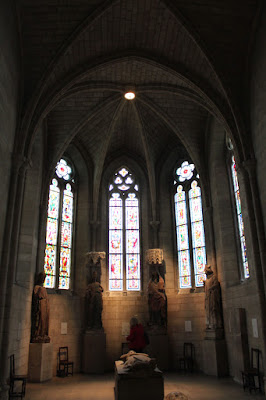When most people plan their trips to New York City, they stay within the confines of downtown Manhattan. They might visit stops on Museum Row like the Guggenheim or Metropolitan Museum of Art, but taking the subway for over 100 blocks seems out of the question.
But there are so many things to see beyond the confines of Central Park and below. Because I’d visited New York City so many times and seen most of the major sights already, I sought out lesser-visited attractions this time around, starting with the Cloisters.


I’d never been farther north than the top of Central Park myself, so on a drizzly day, I left my hotel room near the Meatpacking District and hopped on the L train. I tucked into a back issue of New York magazine and watched as the platforms rushed by on the express train, covering dozens of blocks in minutes.
I hopped off at 190th street and walked through Fort Tryon Park, a green space elevated over the Hudson. Soon I saw the stone structure that I knew had to be The Cloisters.
Opened in 1938 with the support of John D. Rockefeller, the museum is devoted to the art and architecture of medieval Europe. Pieces from medieval cloisters from France, Spain and beyond were brought and reassembled here to create the interior of the city’s most unique museum.
Cloisters, which the museum is named for, are the architectural design usually found in monasteries and nunneries. They’re quiet spaces meant to keep the faithful away from the distractions of the rest of the world. It’s easy to see why. The Cloisters are a quiet place to get away from the noise of New York City.
Once inside, you can spend hours roaming the halls, admiring the work that dates back long before the founding of our country. Over two thousand works from the twelfth to fifteenth centuries cover the walls of the space. It includes items that once beautified the great cathedrals of the day like tapestries, frescoes, triptychs and other decorative items.
Among the well-known pieces are the “Unicorn tapestries,” a set of six pieces from the Netherlands. Considering how old they are, it’s amazing how intricate the stitchwork is and how vibrant the colors still are.
Three of the four cloisters have outdoor space and gardens that make you feel like you’re in rural Italy. I visited during the winter, so there wasn’t much going on in this way, but I could imagine what it’s like during the summer. There’s also an outdoor cafe, open seasonally, but everything was stacked and covered up.
On the day of my visit, there was a scavenger hunt going on, which is just one of the activities you can find at The Cloisters. Staff-guided tours provide additional information to the artwork you’ll find in the museum. The one-hour tours must be booked in advance, as do the audio guides, which are subject to an additional fee. The Cloisters also hosts live music, gallery talks, and family workshops.
I found that an hour was a perfect amount of time for me to explore and if you’re not that interested in medieval art, it may take you even less. I met up with my friend for lunch afterward at Buddha Beer Bar, one of the many restaurants on Broadway.
There’s plenty more to explore in the Washington Heights and Hudson Heights neighborhoods, like the best street art I saw all trip. Fort Tryon is worth a wander around, as are nearby Harlem River Park and Inwood Hill Park.
If You Go
The Cloisters are located at 99 Margaret Corbin Drive, Fort Tryon Park, New York, New York 10040 and open daily from 10 am. Admission is $25 for adults, which also includes admission to The Met for the same day.
I had NO idea that this existed! So beautiful – it looks it’s the Alhambra’s little sister or something?